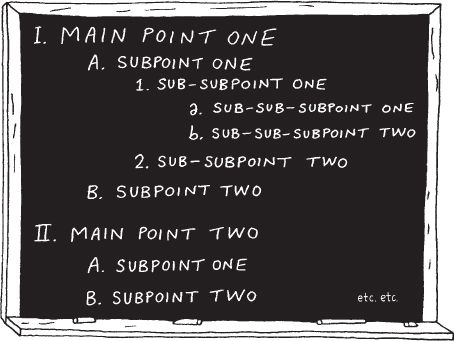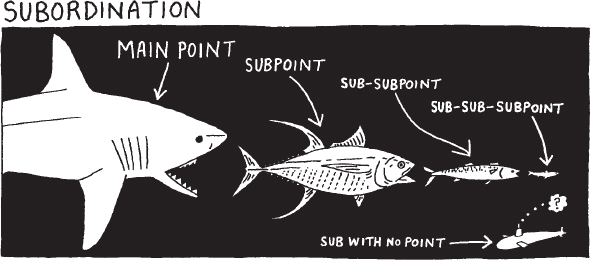Outlining the Body of Your Speech
Printed Page 311
You can think of the body of your speech as representing the “meat” of your presentation. In the body, you’ll present your main points and supporting materials (such as examples, stories, statistics, and testimony from experts). The body thus contains most of the content of your speech. Follow the practices listed in this section to effectively outline the body of your speech.
Use Proper Labeling and Indentation. Start each main point at the left margin of your working outline, and indicate each new main point with a roman numeral. Indent each of your subpoints, and label them with capital letters. If you develop a subpoint further with two or more supporting ideas, indicate each of these sub-subpoints with arabic numerals, and indent the sub-subpoints another step beneath the subpoint they support. Typically, you’ll want to include between two and four subpoints for each main point, and the same number of sub-subpoints for each subpoint. (In a proper outline, support can never stand alone; in other words, you must always include a minimum of two subpoints supporting each main point and two sub-subpoints supporting each subpoint.)

Use Full Sentences or Detailed Phrases. In your working outline, you should express your main ideas, subpoints, and sub-subpoints in complete sentences or detailed phrases (each instructor will have his or her own preference for the level of detail required). As noted earlier, your working outline should be detailed enough that another person could deliver your speech from it. Furthermore, your instructor is likely to require you to turn in a copy of your working outline. If it is too brief, he or she may misinterpret the points you want to make or, even worse, conclude that you haven’t put enough effort into preparing your speech.

Check for Subordination. In a well-organized speech, supporting materials show subordination to their corresponding main points. Thus, be careful that each subpoint is relevant to the main point it’s supposed to support and that each sub-subpoint relates to its corresponding subpoint. How can you tell whether your supporting materials show appropriate subordination to their corresponding point? Complete the following sentence for each of your supporting materials:
“This supports the point I am making because . . .”
If you can’t come up with a logical way to complete this sentence, you may need to reexamine your supporting materials and find ways to make them more clearly relevant. For example, you might want to move a subpoint to a place in your outline where the idea fits better. Or you may decide to reword a main point or subpoint so that the supporting material more clearly explains or expands the idea it is meant to support. Finally, you could consider developing a supporting example or explanation into a main point.

Include Full Information for Citations, Quotations, and Other Evidence. When you use evidence to support a claim, you need to include in your working outline all the information about the source of your evidence—the author, his or her qualifications, the source publication or Web page, and the date of publication. And if you are quoting a source, be sure to present the information word-for-word and enclose the information in quotation marks to indicate that you are using someone else’s words.
For example, here’s how you would outline evidence for a commemorative speech about Cammi Granato, one of the first two women elected to the Hockey Hall of Fame and a two-time U.S. Olympic Team captain. In this case, the evidence is used as subpoint A, which supports a main point about the beginning of Granato’s hockey career:

- Cammi Granato got an early start on her hockey career.
- Cammi Granato honed her skills by playing hockey with her brothers. According to Ken Campbell, senior editor for the Hockey News, in American Hockey Magazine, December 1997: “The Granato kids painted lines on the floor, set up nets, and played two on two, Tony and Cammi against Donnie and Robbie. ‘Those games got pretty intense,’ Tony recalls. ‘But Cammi hung right in there and she never backed down. She was one of the most tenacious kids I’ve ever seen.’”
Insert Transitions. As discussed in earlier chapters, a transition is a sentence that indicates you are moving from one part of your speech to another. Using transitions helps you keep on track and makes it easier for listeners to follow along. At minimum, include transitions
- between the introduction and the body,
- when you move from one main point to the next,
- between the body and the conclusion.
In your outline, indicate a transition by labeling it and placing it in brackets, as shown in the following example:
[TRANSITION
We have considered the physical skills needed to become a Navy Seal; next, let’s turn our attention to mental abilities.]
Click the "Next" button to try Video Activity 11.1, “Roth, Emergency in the Emergency Room.”